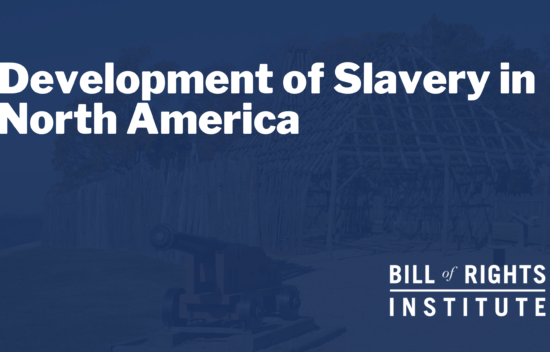



Homework Help Playlist
59 items

Federalism | BRI’s Homework Help Series
Video
Video
5 Min
This Homework Help narrative explores the history of the Founding of the U.S. and the reasons why federalism was created as an important part of our constitutional system. The video challenges viewers to consider this question: why we have a system with local, state, and federal laws?
5 Min

Eighth Amendment | BRI’s Homework Help Series
Video
Video
How do we determine the punishment for those accused or convicted of a crime? What is the 8th amendment? Our latest Homework Help video explores this question and provides students with a succinct overview of the essential information regarding the 8th amendment.
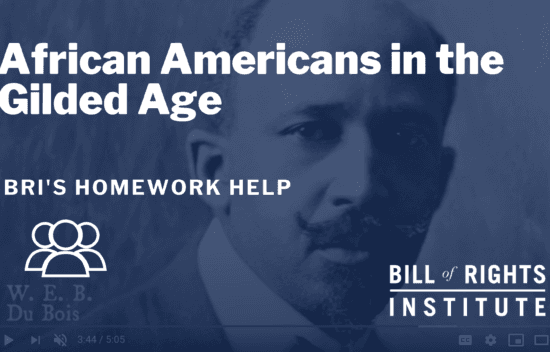
African Americans in the Gilded Age | BRI’s Homework Help Series
Video
Video
5 Min
The first in our new Institute of History Series of Homework Help videos provides a general overview of the experience of African Americans during the pivotal years of the Gilded Age, from the 1860s to the early 1900s. Despite the passage of the 13th, 14th, and 15th Amendments to the Constitution after the Civil War, which abolished slavery and granted citizenship and voting rights to African American men, millions of African Americans across the nation still faced an uphill struggle for equality and civil rights. Political disenfranchisement was widespread and segregation in the form of "Jim Crow" laws affected nearly every facet of public and private life in the South. Many African Americans migrated from the South to the North and West during this period. This era also saw the rise of dozens of notable African American civil rights leaders including Ida B. Wells, Frederick Douglass, Booker T. Washington, and W.E.B. Du Bois. Groups like the N.A.AC.P. were also established during this period to fight for the expansion of liberty and equality for African Americans.
5 Min

Entrepreneurs: A History | BRI’s Homework Help Series
Video
Video
4 Min
"Entrepreneurs" is our latest Evidence of History Homework Help video focusing on the so-called "Robber Barons" or "Captains of Industry" of the late 19th and early 20th century, including Andrew Carnegie, John D. Rockefeller, J.P. Morgan, and Henry Ford. How did these men and those like them transform the U.S. economy during the Gilded Age, and what, if any, lessons do their stories have for us today? Watch and find out!
4 Min
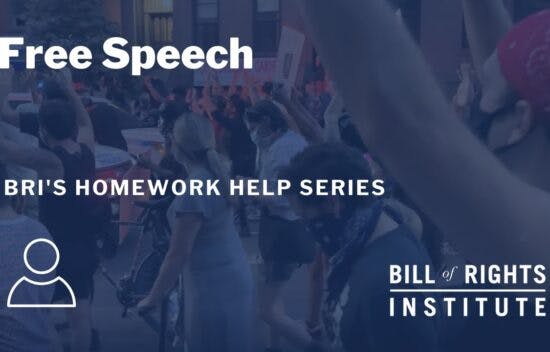
Free Speech | BRI’s Homework Help Series
Video
Video
7 Min
Why is the freedom of speech a bedrock principle in American society? In this Homework Help video, we explore the history of freedom of speech in the United States.
7 Min
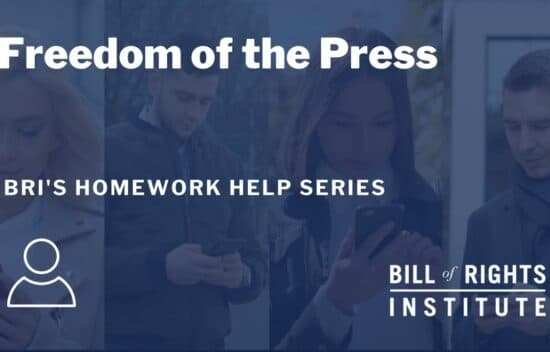
Freedom of the Press | BRI’s Homework Help Series
Video
Video
6 Min
What do you think of when you hear the words "free press"? The Founders believed the freedom of the press was an important bulwark in a free society. Learn more about the history of the First Amendment as well as some landmark Supreme Court cases involving press freedom with this Homework Help video.
6 Min

Dred Scott v. Sandford | Homework Help from the Bill of Rights Institute
Video
Video
3 Min
The Dred Scott v. Sandford case of 1857 was brought to the Supreme Court just four years before the start of the Civil War. Dred Scott sued his master for his freedom and Judge Robert Taney ultimately ruled two things. First, African Americans were not citizens and had no right to sue in court. Second, Congress did not have the constitutional authority to ban slavery from the states. This case is considered one of the worst rulings in the history of the Supreme Court.
3 Min

Brown v. Board of Education | BRI’s Homework Help Series
Video
Video
4 Min
Brown v Board of Education was a case brought to the Supreme Court in 1954 after Linda Brown, an African American student in Kansas, was denied access to the white-only schools nearby her house. Future Supreme Court Justice Thurgood Marshall was the lawyer for the case, and argued that segregated schools were inherently unequal. Ultimately, the Supreme Court ruled in favor of Linda Brown and declared segregation unconstitutional under the Equal Protection Clause of the 14th Amendment through incorporation under the premise that the bill of rights also applies to the states. This is one of the landmark cases that led to the passage of the Civil Rights Act of 1964.
4 Min
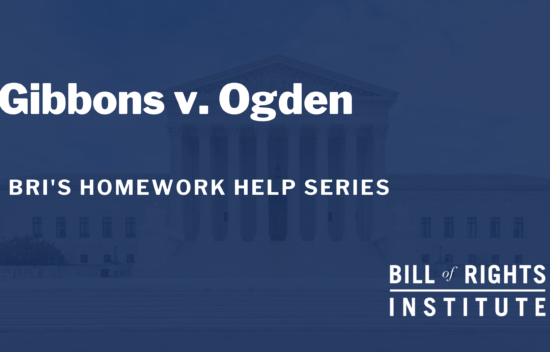
Gibbons v. Ogden | BRI’s Homework Help Series
Video
Video
3 Min
Gibbons v. Ogden was a Supreme Court case dealing with interstate commerce. In 1824, New York created a law that granted Aaron Ogden a monopoly over steamboat access to the Hudson River. Thomas Gibbons held a federal license to operate his steamboat between New York and New Jersey. Gibbons won unanimously through his connection of the Interstate Commerce Clause and Supremacy Clause. New York’s law was overturned and Gibbons, along with other steamboat operators were able to participate in Interstate Commerce via waterways.
3 Min

Citizens United v. FEC | BRI’s Homework Help Series
Video
Video
4 Min
Citizens United v. FEC was a Supreme Court case surrounding campaign finance and corporate involvement in politics. The Federal Election Commission was created in 1971 and greatly regulated the amount of campaign finance political candidates were able to receive. By 2002, the Bipartisan Campaign Finance Reform Act (McCain-Feingold Act) restricted organizations from financing issue-based advertisements on behalf of candidates. Citizens United released a million dollar ad against Hillary Clinton. Before the film aired, Citizens United challenged the McCain-Feingold Act, stating that money was a form of Free Speech, which is protected by the First Amendment. The Supreme Court ruled the McCain-Feingold Act as unconstitutional, but stated that corporations still cannot give money directly to political candidates.
4 Min

Foreign Impact During the Revolution | BRI’s Homework Help Series
Video
Video
5 Min
Have you ever looked at your teacher with a puzzled face when they explain history? I know we have. In our new Homework Help Series we break down history into easy to understand 5 minute videos to support a better understanding of American History.
5 Min

Colonial Culture | BRI’s Homework Help Series
Video
Video
5 Min
Have you ever looked at your teacher with a puzzled face when they explain history? I know we have. In our new Homework Help Series we break down history into easy to understand 5 minute videos to support a better understanding of American History. In our fourth episode, we tackle Colonial Culture in the 1600 and 1700's.
5 Min
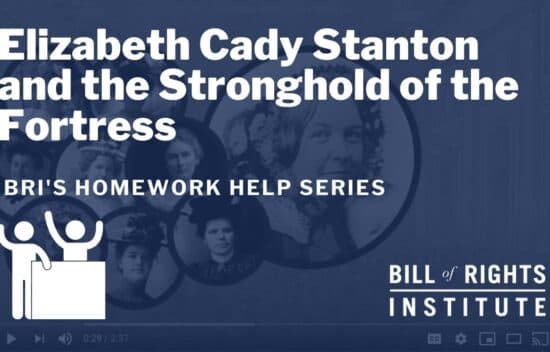
Elizabeth Cady Stanton and the Stronghold of the Fortress | BRI’s Homework Help Series
Video
Video
3 Min
In this Homework Help Narrative, learn about the courage and determination of Elizabeth Cady Stanton and the origins of the Seneca Falls Convention of 1848.
3 Min

Early 1800s US Foreign Policy | BRI’s Homework Help Series
Video
Video
5 Min
Have you ever looked at your teacher with a puzzled face when they explain history? I know we have. In our new Homework Help Series we break down history into easy to understand 5 minute videos to support a better understanding of American History. In our tenth episode, we tackle early American foreign policy.
5 Min
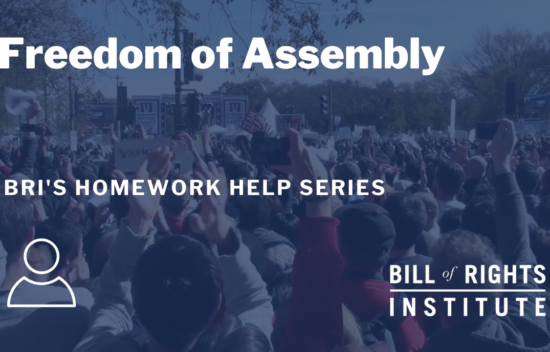
Freedom of Assembly | BRI’s Homework Help Series
Video
Video
6 Min
Why is the freedom of assembly an essential right in a free society? Our Homework Help video explores why the Founders included it in the 1st Amendment as well as the landmark Supreme Court cases involving it. Supreme Court cases arguing freedom of assembly debate the protections of the 14th Amendment. Although the Bill of Rights was initially limited to the federal government, incorporation also allows states to be culpable of the protections in the Bill of Rights.
6 Min
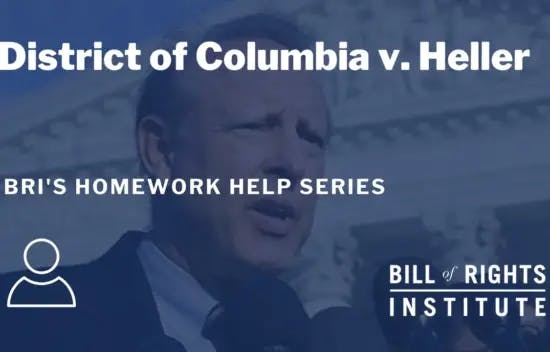
District of Columbia v. Heller | BRI’s Homework Help Series
Video
Video
Does the 2nd Amendment protect an individual or a collective right to bear arms? Find out the answer to this question in the latest episode of BRI's Homework Help Series on the case of District of Columbia v. Heller. 2008 Supreme Court case

Incorporation | BRI’s Homework Help Series
Video
Video
4 Min
In this Homework Help narrative, learn about the constitutional principle of incorporation and its historic context. After the passage of the 14th Amendment, the Due Process Clause caused many national and state debates, leading to the idea of incorporation and the fundamental question of whether the Bill of Rights applies to states as well as the federal government.
Has incorporating the Bill of Rights to apply to the states created greater liberty for Americans?
4 Min

Griswold v. Connecticut | BRI’s Homework Help Series
Video
Video
Does the Constitution protect a right to privacy within marriage? Find out the answer to this question in the latest episode of BRI's Homework Help Series.
Griswold v. Connecticut debates the right to privacy under the 14th Amendment. Incorporation allows the Bill of Rights and subsequent amendments, including the 14th Amendment, to apply to the states and not only the federal government.
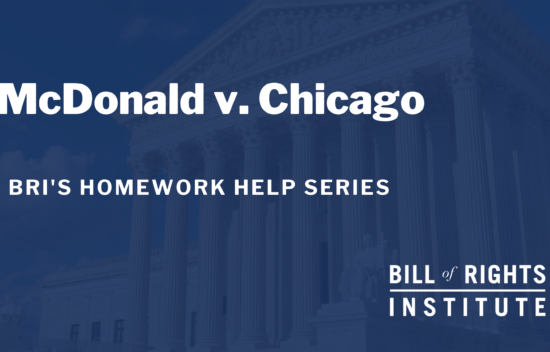
McDonald v. Chicago | Homework Help from the Bill of Rights Institute
Video
Video
4 Min
Does the Second Amendment prevent a city from effectively outlawing handgun ownership? In 2008, Otis McDonald attempted to purchase a handgun for self-defense purposes in a Chicago suburb. However, the city of Chicago had banned handgun ownership in 1982 when it passed a law that prevented issuing handgun registrations. McDonald argued this law violated the Fourteenth Amendment’s Privileges and Immunities Clause as well as the Due Process Clause. In a 5-4 decision, the Court ruled that McDonald’s Second Amendment right to bear arms was protected at the state and local level by the Due Process Clause of the Fourteenth Amendment.
4 Min

Marbury v. Madison | BRI’s Homework Help Series
Video
Video
3 Min
Marbury v. Madison was the Supreme Court case that established judicial review. William Marbury was a judge appointed at the end of John Adams’ presidency, but never got his official commission papers. Once Thomas Jefferson became president, James Madison refused to deliver the commission papers. Marbury took his case to the Supreme Court and wanted a Writ of Mandamus, requiring Madison to deliver the papers. Ultimately, the court stated that Marbury was entitled to his papers, but it was unconstitutional for the courts to issue a Writ of Mandamus. Thus, judicial review was created and the principle of checks and balances was strengthened.
3 Min
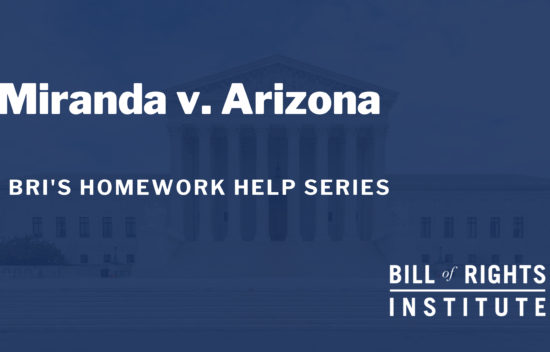
Miranda v. Arizona | BRI’s Homework Help Series
Video
Video
3 Min
Miranda v. Arizona was a case brought to the Supreme Court in 1966 after Ernesto Miranda appealed his guilty conviction of kidnapping and rape. In his appeal, Miranda claimed he was unaware of his right to remain silent and his resulting confession should not be used to incriminate him. The Supreme Court ruled in favor of Miranda and established the Miranda Warning. This warning is now recited in most instances of arrest to ensure the accused people are aware of their rights.
3 Min
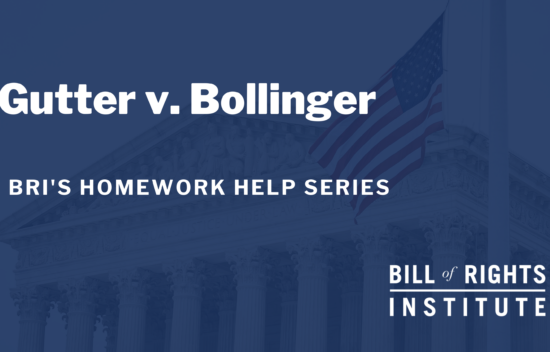
Grutter v. Bollinger | BRI’s Homework Help Series
Video
Video
4 Min
Grutter v. Bollinger was a case brought to the Supreme Court over the use of Affirmative Action in the college admissions process. The University of Michigan Law School denied acceptance to Barbara Grutter, despite her impressive resume. Grutter, a white woman, believed that her rejection was based on her race. The Supreme Court Justices ultimately ruled that the University of Michigan Law School’s admissions process was constitutional and did not violate the Equal Protection Clause in the 14th Amendment. Incorporation, the process of states being held liable to the Bill of Rights, allowed the Supreme Court to hear and rule on the case.
However, there was doubt among the most conservative Supreme Court justices like Scalia and Rehnquist that affirmative action policy was a constitutional practice for university admission departments to take part in. Affirmative Action is still a highly debated topic today.
What is Affirmative Action? Affirmative Action is a policy, usually carried out by schools, businesses, government entities, and federal contractors, in which individuals of minority racial status are afforded preferential treatment on the basis of race. Affirmative action came about as part of a desire to rectify the traditional underrepresentation of minority peoples in desirable professions and universities, which negatively impacted their financial and social conditions.
4 Min

Immigration to America | BRI’s Homework Help Series
Video
Video
5 Min
The rise in immigration to the United States in the 1840's altered the economic, cultural, and political climate of the nation in the first half of the 19th century.
5 Min

National Identity In The Early 1800s | BRI’s Homework Help Series
Video
Video
5 Min
Have you ever looked at your teacher with a puzzled face when they explain history? I know we have. In our new Homework Help Series we break down history into easy to understand 5 minute videos to support a better understanding of American History. In our eleventh episode, we tackle national identity in early America.
5 Min
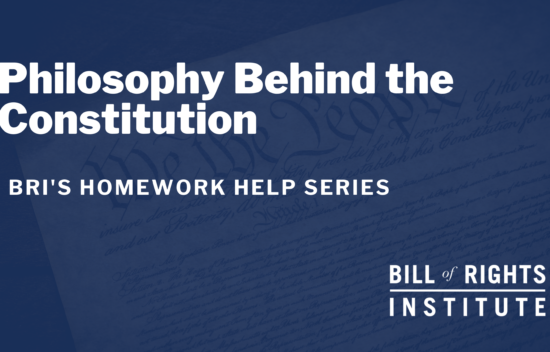
Philosophy Behind the Constitution | BRI’s Homework Help Series
Video
Video
6 Min
Have you ever looked at your teacher with a puzzled face when they explain history? I know we have. In our new Homework Help Series we break down history into easy to understand 5 minute videos to support a better understanding of American History.
What happened at the Constitutional Convention? In our seventh episode, we tackle the philosophical ideas behind the United States Constitution during the Constitutional Convention. Deep dive into the mindset of The Founders and learn different ways to interpret the US Constitution.
6 Min
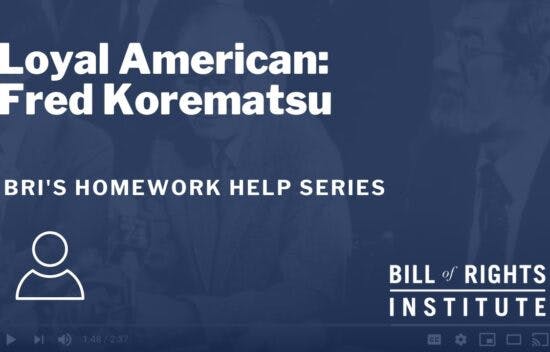
Loyal American: Fred Korematsu | BRI’s Homework Help Series
Video
Video
3 Min
In this Homework Help narrative, learn the story of Fred Korematsu and his lifelong struggle for justice for himself and the thousands of Japanese-Americans wrongfully interned by the U.S. government during World War II.
3 Min

McCulloch v. Maryland | BRI’s Homework Help Series
Video
Video
4 Min
McCulloch v. Maryland was the 1819 Supreme Court case dealing mostly with the issue of Federalism. The creation of a National Bank was encouraged by Alexander Hamilton, but opposed by Thomas Jefferson, due to lack of authority given by the Constitution. A National Bank was chartered, but then died 20 years later. In 1816, a National Bank was re-instated to help deal with debts from the War of 1812. This Second National Bank, established in Maryland, was taxed heavily by Thomas Jefferson and the State of Maryland. Federal Bank Cashier, James McCulloch, refused to pay the tax, stating that the state did not have the right to tax an institution of the Federal Government. Ultimately, the Supreme Court stated that Congress had the right to create the National Bank, under the Necessary and Proper Clause. Also, the State of Maryland did not have the right to tax the National Bank and the Federal Government under the Supremacy Clause.
4 Min
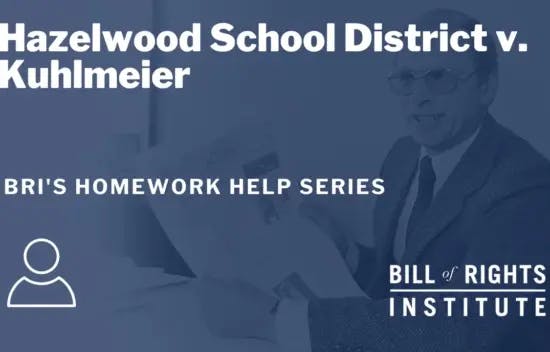
Hazelwood v. Kuhlmeier | BRI’s Homework Help Series
Video
Video
What free speech rights do you have as a student? In the Hazelwood v. Kuhlmeier (1988) Supreme Court ruling, the court found that articles written in the school newspaper are not subject to 1st Amendment, freedom of speech rights for student journalist. Learn how the court came to this answer in the latest episode of BRI's Homework Help Series on the case of Hazelwood v. Kuhlmeier.
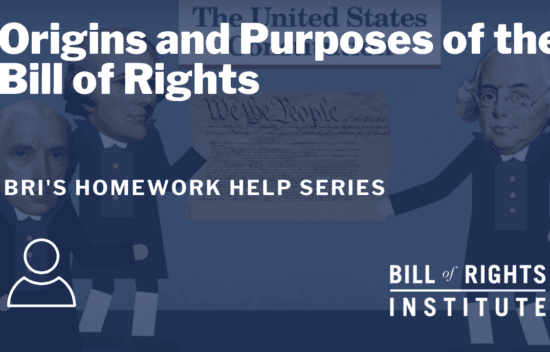
Origins and Purposes of the Bill of Rights | BRI’s Homework Help Series
Video
Video
6 Min
Why did the Founders see the need to create a Bill of Rights in addition to the US Constitution? What historical documents and events influenced them as they drafted it? The Virginia Declaration of Rights written by James Madison, the Magna Carta, the Petition of Rights, the English Bill of Rights, and the Massachusetts Body of Liberties.
The Founders included both concepts of democracy and republic in the blueprint for American government. Democracy protected majority rule whereas the idea of a republic protected individual citizens. The Bill of Rights was an important addition to the Constitution because it helped to guarantee individual rights. As a fluid document, inclusions to the Bill of Rights like the 14th Amendment brought the idea of incorporation, the process of states being held liable to uphold the Bill of Rights on the state level.
This latest installment in our Homework Help series explores these important constitutional questions.
6 Min
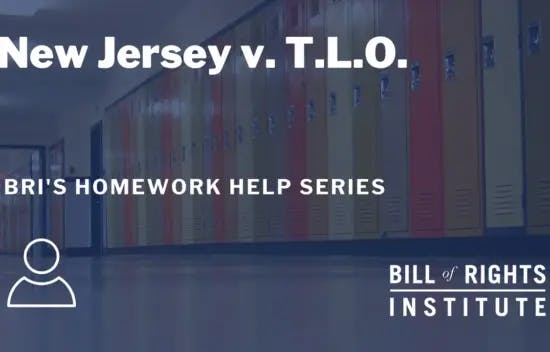
New Jersey v. T.L.O. | BRI’s Homework Help Series
Video
Video
The New Jersey v. T.L.O. (1985) Supreme Court case questions if school officials can randomly search student property while at school under the 4th Amendment? Find out the answer to this question in the latest episode of BRI's Homework Help Series on the case of New Jersey v. T.L.O.
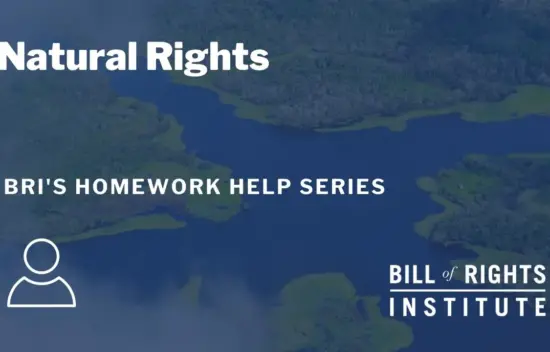
Natural Rights | BRI’s Homework Help Series
Video
Video
What are natural rights? The natural rights definition is the belief that certain rights such as life, liberty, and property belong to humans by nature and can only be justly abridged through due process.
How did the idea of natural rights shape the understanding of self-government? Our latest Homework Help video explores this question and provides students with a succinct overview of the essential information regarding life, liberty, and the pursuit of happiness.

Sixth Amendment | BRI’s Homework Help Series
Video
Video
What protections exist for Americans accused of a crime? The 6th Amendment. What is the 6th Amendment?
The 6th Amendment provides defendants with rights to a speedy and fair trial, an impartial jury, and more. Our latest Homework Help video explores the 6th Amendment and provides students with a succinct overview of the essential information regarding this amendment.

Seventh Amendment | BRI’s Homework Help Series
Video
Video
What is the 7th Amendment? What protections does the 7th Amendment provide if you are involved in a lawsuit? Explore the 7th Amendment simplified in our latest Homework Help video discussing this question and providing students with a succinct overview of the essential information regarding this amendment.
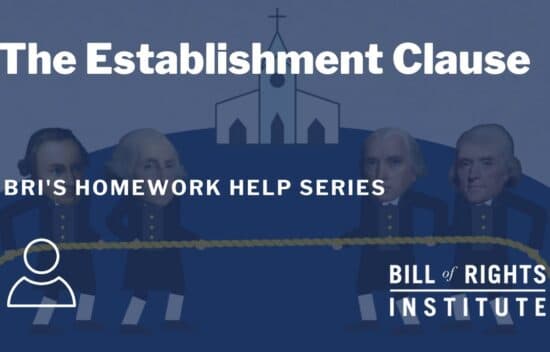
The Establishment Clause | BRI’s Homework Help Series
Video
Video
9 Min
What is the proper relationship between church and state? In this Homework Help video, we analyze this question by reviewing the history behind the Establishment Clause of the First Amendment as well as how the Supreme Court has interpreted its meaning.
9 Min

The Colonization of America | BRI’s Homework Help Series
Video
Video
6 Min
Have you ever looked at your teacher with a puzzled face when they explain history? I know we have. In our new Homework Help Series we break down history into easy to understand 5 minute videos to support a better understanding of American History. In our second episode, we tackle the colonization of America.
6 Min

The Columbian Exchange | BRI’s Homework Help Series
Video
Video
6 Min
Have you ever looked at your teacher with a puzzled face when they explain history? I know we have. In our new Homework Help Series we break down history into easy to understand 5 minute videos to support a better understanding of American History. In our first episode, we tackle the Columbian Exchange and early contact between Europeans, Natives and Africans.
6 Min
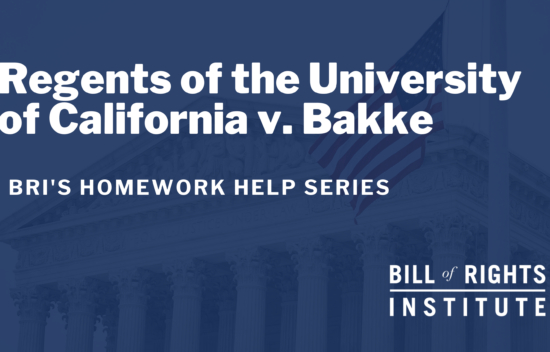
Regents of the University of California v. Bakke | BRI’s Homework Help Series
Video
Video
4 Min
Regents of the University of California v. Bakke was a case brought to the Supreme Court over the use of Affirmative Action in the college admission process. The University of California at Davis Medical School created a minimum minority student quota for the admissions department to fill each year. Bakke, a two-time UC-Davis Med School rejected applicant, sued the school for violation of the Equal Protection Clause of the 14th Amendment and Title VI of the Civil Rights Acts. Ultimately, the Supreme Court justices ruled in support of the goals of Affirmative Action because of incorporation, the idea that the states must adhere to the protections of the Bill of Rights. They also stated that Bakke was, in fact, denied equal protection. This decision, because it was so muddled, did not set long-term precedents or clarifications concerning Affirmative Action.
What is Affirmative Action? Affirmative Action is a policy, usually carried out by schools, businesses, government entities, and federal contractors, in which individuals of minority racial status are afforded preferential treatment on the basis of race. Affirmative action came about as part of a desire to rectify the traditional underrepresentation of minority peoples in desirable professions and universities, which negatively impacted their financial and social conditions.
4 Min

Schenck v. United States | BRI’s Homework Help Series
Video
Video
3 Min
Schenck v. United States was a Supreme Court Case that explained some limits to the Freedom of Speech afforded by the First Amendment. During World War I, the US instituted a military draft. Many people released anti-war and anti-government information due to their displeasure with the draft. Charles Schenck, an anti-war socialist, was arrested by the Federal Government for circulating a pamphlet encouraging men to resist the draft and violating the Espionage Act of 1917. The Supreme Court ruled that wartime circumstances changed the rules related to free speech and resulted in the “Clear and Present Danger” rule.
3 Min

The Fourth Amendment | BRI’s Homework Help Series
Video
Video
5 Min
What prevents the police from randomly searching our homes and possessions whenever they want? The Founders created the Fourth Amendment to protect the individual right to private property. Learn more about its origins and some landmark Supreme Court cases in our latest Homework Help video.
5 Min

The Articles of Confederation | BRI’s Homework Help Series
Video
Video
4 Min
Have you ever looked at your teacher with a puzzled face when they explain history? I know we have. In our new Homework Help Series we break down history into easy to understand 5 minute videos to support a better understanding of American History. In our eighth episode, we tackle the Articles of Confederation and the need for a Constitution.
4 Min

The Fifth Amendment | BRI’s Homework Help Series
Video
Video
6 Min
What protections does the Fifth Amendment provide, and why did the Founders believe them important enough to enshrine in the Bill of Rights? Our latest Homework Help video explores these questions and provides students with a succinct overview of the essential information regarding this amendment.
6 Min

Road To Revolution | BRI’s Homework Help Series
Video
Video
5 Min
Have you ever looked at your teacher with a puzzled face when they explain history? I know we have. In our new Homework Help Series we break down history into easy to understand 5 minute videos to support a better understanding of American History. In our fifth episode, we tackle the road to the American Revolution.
5 Min
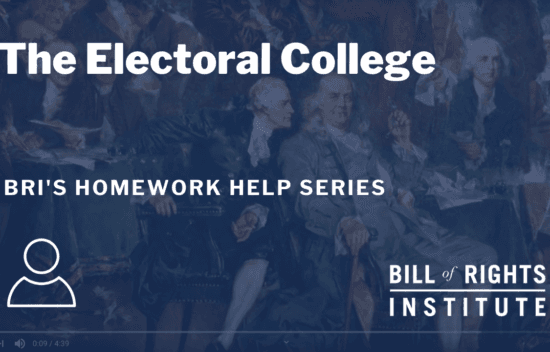
The Electoral College | Homework Help from the Bill of Rights Institute
Video
Video
7 Min
In this Homework Help narrative, learn about the origins and functions of the Electoral College. This constitutional institution has long been the subject of intense debate and scrutiny, and this video challenges students to think about it for themselves.
7 Min

The Constitution | BRI’s Homework Help Series
Video
Video
5 Min
Why did the Articles of Confederation fail? In our eighth episode, we tackle the Articles of Confederation and the need for a Constitution at the Constitutional Convention. Learn how the US Constitution made provisions for a stronger federal government, state rights and powers, and personal rights formally known as the Bill of Rights.
Have you ever looked at your teacher with a puzzled face when they explain history? I know we have. In our new Homework Help Series we break down history into easy to understand 5 minute videos to support a better understanding of American History.
5 Min
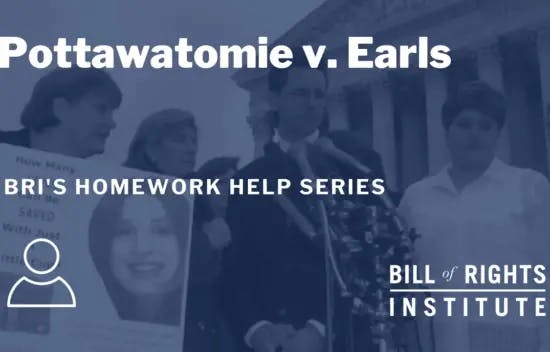
Pottawatomie v. Earls | BRI’s Homework Help Series
Video
Video
What rights do American students have in regards to drug testing in schools? Find out the answer to this question in the latest episode of BRI's Homework Help Series on the case of Pottawatomie v. Earls.

Reconstruction | BRI’s Homework Help Series
Video
Video
10 Min
How did the United States attempt to reunite after the Civil War while also securing the rights of recently freed enslaved people with the passage of the 13th Amendment, 14th Amendment and 15th Amendment? How successful was our country in accomplishing these goals? Did the Reconstruction Amendments hurt or help the cause? What were the effects of the Reconstruction Amendments on the states due to incorporation?
Our latest Homework Help video explores these questions while encouraging students to analyze the Reconstruction period and its relationship with the principles of liberty and equality.
10 Min
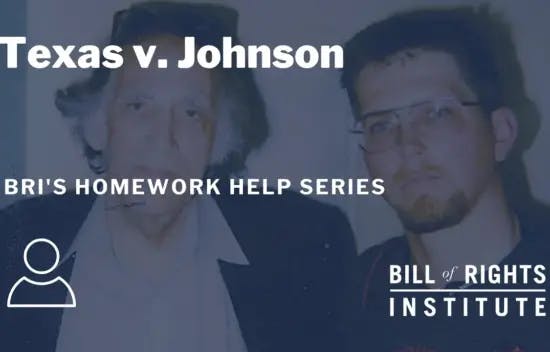
Texas v. Johnson | BRI’s Homework Help Series
Video
Video
Should burning the American flag be considered a form of expression protected by the First Amendment? Learn how the Supreme Court addressed this controversial question in the case of Texas v. Johnson.
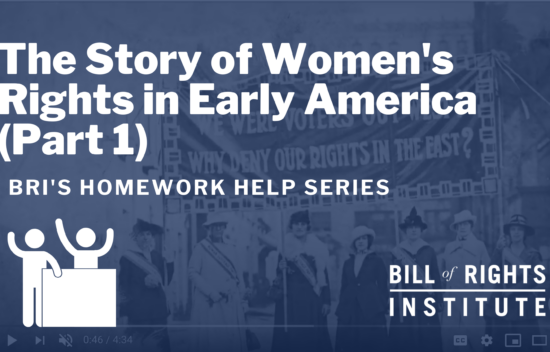
The Story of Women’s Rights in Early America (Part 1) | BRI’s Homework Help History Series
Video
Video
5 Min
In part one of this two-part Homework Help narrative, learn about the origins of the women’s suffrage movement from Colonial America through the nineteenth century. What challenges did these brave activists need to overcome in the early days of the movement to lay the groundwork for the passage of the 19th Amendment? How did previous protections granted in the Bill of Rights like the 14th Amendment and incorporation, the responsibility of states to adhere to the Bill of Rights, boost the case for women’s rights.
5 Min
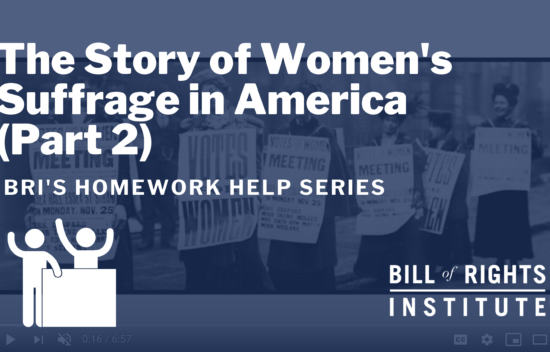
The Story of Women’s Suffrage in America (Part 2) | BRI’s Homework Help History Series
Video
Video
7 Min
In part two of this two-part Homework Help narrative, learn about the challenges that the women’s suffrage movement overcame in the late nineteenth and early twentieth centuries. What contributions did monumental suffragists like Alice Paul, Lucy Stone, and Carrie Chapman Catt make on the journey to winning the vote for women?
7 Min

The Notorious Aaron Burr | BRI’s Homework Help Series
Video
Video
5 Min
You may know him as the man who killed Alexander Hamilton, but do you know the full story of one of American History's most notorious characters? Our latest Homework Help Institute of History video brings you the story of Aaron Burr, his rise to the position of governor of New York and vice president of the United States, and his spectacular downfall.
5 Min

The Story of “Boss” Tweed | BRI’s Homework Help Series
Video
Video
5 Min
This first in our new Homework Help Evidence of History series tells the story of William "Boss" Tweed. Tracing his rise to political power in post Civil War New York City, a metropolis whose population was booming from an influx of European immigrants, this video explores the question of whether Tweed was a hero, a villain, or something in between. Examine the evidence and decide for yourself.
5 Min

The Origins of Partisanship | BRI’s Homework Help Series
Video
Video
5 Min
This latest installment of our Homework Help Institute of History series addresses the origins of partisanship in the United States. In the late 18th Century, the new nation was at risk of being torn apart as factions developed between Federalists and Anti-Federalists whose differences over the nature and structure of the new government played out in pamphlets, newspaper essays, state ratifying conventions, in taverns, and on street corners. Some compromise was reached with the ratification of The Bill of Rights, but differences over policy continued to play out among factions and the Federalists and Democratic-Republican parties formed. This video is intended as a general overview of this period of U.S. History, and a springboard for a deeper exploration of the various political disputes of the late 1700s and early 1800s.
5 Min

The Free Exercise Clause | BRI’s Homework Help Series
Video
Video
6 Min
Why did the Founders believe that religious liberty was an inalienable right? In this Homework Help video, we explore the history behind the Free Exercise Clause of the First Amendment and how the Supreme Court has interpreted it.
6 Min

The Second Amendment | BRI’s Homework Help Series
Video
Video
5 Min
What are the origins of the Second Amendment, and how has it been interpreted throughout U.S. history? This Homework Help video explores the history of the Second Amendment as well as the Supreme Court interpretations of it that shape current discussions on the topic of gun control.
5 Min

The Rise of Mass Politics: Jacksonian Democracy | BRI’s Homework Help Series
Video
Video
5 Min
Have you ever looked at your teacher with a puzzled face when they explain history? I know we have. In our new Homework Help Series, we break down history into easy to understand 5-minute videos to support a better understanding of American History. In this episode, we examine the Rise of Mass Politics and Jacksonian Democracy.
5 Min
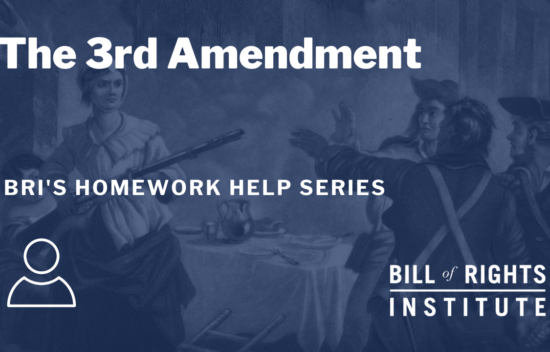
The Third Amendment | BRI’s Homework Help Series
Video
Video
7 Min
Why did the Founders believe so strongly that troops should not be quartered in the homes of citizens that they enshrined this protection in the Bill of Rights? The Third Amendment is rarely talked about, but studying its origins and purposes is important in order to understand our system of the relationship between civilians and the military. Learn more about the story of the Third Amendment with this Homework Help video.
7 Min
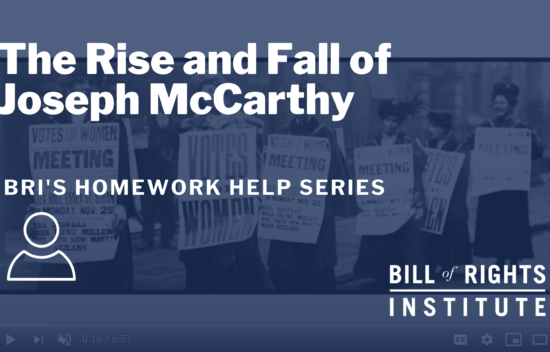
The Rise and Fall of Joseph McCarthy | BRI’s Homework Help Series
Video
Video
4 Min
Our latest Homework Help Evidence of History video tells the story of the rise and fall of Senator Joseph McCarthy, a fierce partisan and demagogue whose battles against Communism in early 1950s America utilized the new medium of television to garner public attention. Preying upon the public's fear of communism within the U.S. government, he hurled accusations against numerous political enemies often with little or no evidence, and with scant regard to the principles of due process, free speech, and liberty. The new medium of television, which helped his meteoric political rise, would ultimately play a key role in his undoing.
4 Min
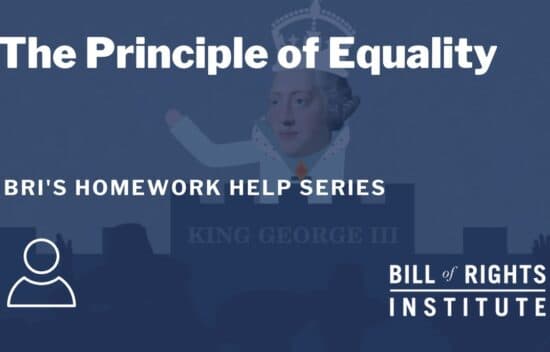
The Principle of Equality | BRI’s Homework Help Series
Video
Video
6 Min
Why is equality a bedrock principle in the United States? Our final Homework Help video of 2021 explores the origins of this principle and how our nation has not always lived up to it throughout our history.
6 Min
